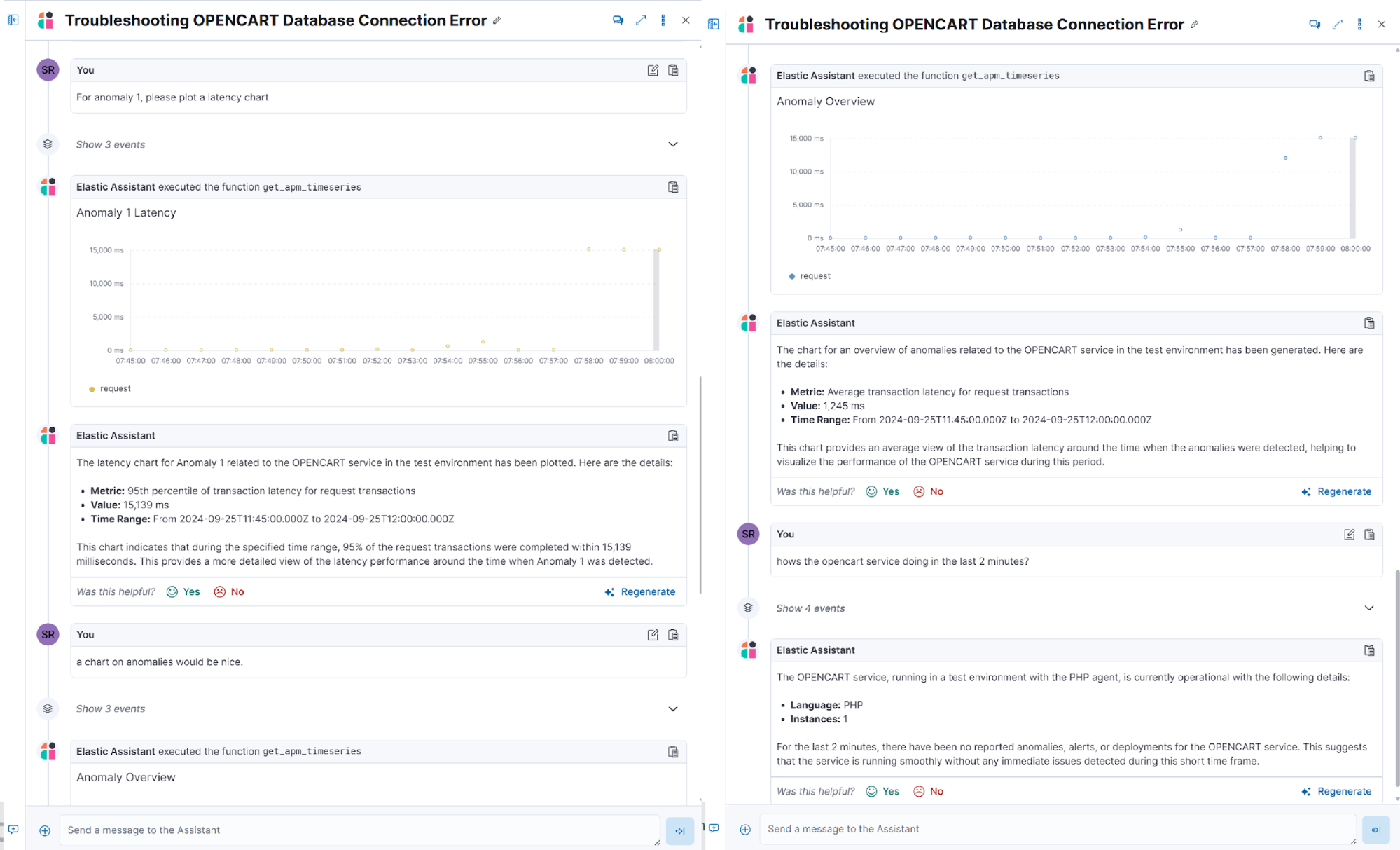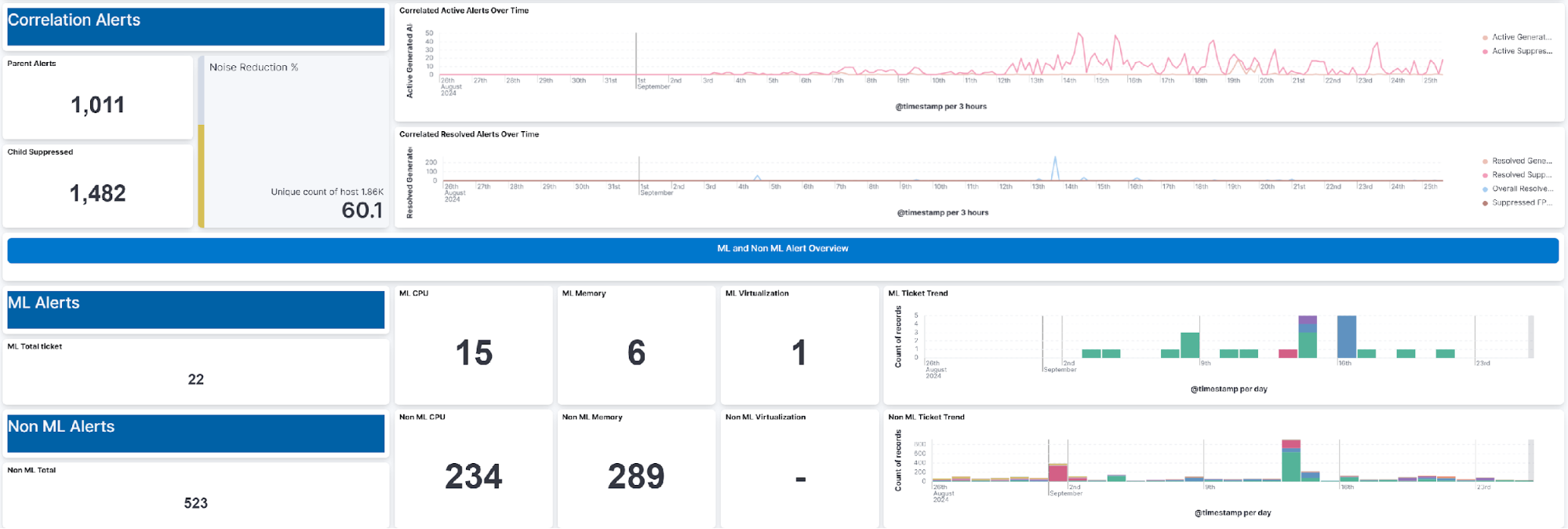Reduces new hire training from 1 year to 3 months
With Elastic AI Assistant, new hires can take on client projects in a matter of months while reducing reliance on lead engineers by 90%, thanks to generative AI features.
Reduces false positives by 75%
With Elastic Observability, Hexaware reduced false positives significantly in many use cases, including one where they fell from 1,000 per week to just 244.
Improved operational efficiency by 50% with AI Assistant
With Elastic AI Assistant, Hexaware teams working on managed service customer projects experienced a 50% improvement in operational efficiency by streamlining access to real-time insights.
Retrieves critical KPI data and charts in seconds
With Elastic AI Assistant, employees can retrieve KPI data and request customized charts in minutes rather than hours.
Advanced AI and machine learning give Hexaware a boost in the competitive managed services sector
Many IT companies claim to be 'AI-First,' but few embody it like Hexaware, an India-based IT services firm with 30,000 employees and $1.3 billion in revenue. With 80% of its workforce certified in advanced AI skills, Hexaware's commitment to this vision is evident in its intensive employee training and AI-driven growth.
Hexaware has put Elastic at the heart of its AI roadmap, which is already transforming IT operations for the business and its clients. It deployed Elastic Observability to detect and address system anomalies. Additionally, the business implemented Elastic AI Assistant, a generative AI tool that enables users to interact with Elastic for tasks such as alert investigation, incident response, and query generation using natural language.

Generative AI: Driving transformation
Sanjesh Rao, VP of Product Strategy & Innovation at Hexaware, says that Elastic AI Assistant is driving IT transformation in two key areas. First, it enables Hexaware to hire talented engineers directly from university and swiftly integrate them into client projects as part of its 'Mavericks Program'.
These new hires no longer need to memorize complex error codes. Simply clicking on a code triggers Elastic AI Assistant to provide valuable context, potential causes, and suggested solutions. This not only boosts productivity for new starters, but also reduces reliance on lead engineers by up to 90%.
"Our Mavericks program leverages Elastic AI Assistant to accelerate onboarding and on-the-job training. This enables us to deploy new talent in just three months rather than a year or even 18 months."
Elastic AI Assistant also streamlines application and service monitoring. Instead of having to check dozens of dashboards and hundreds of KPIs, a Hexaware employee can type a question in plain English, such as 'how was this service running between midnight and six in the morning'. Elastic AI Assistant then replies, listing anomalies that occurred during this time period. The employee can follow up with further questions, such as 'did any transactions fail when these anomalies occurred'. This has improved operational efficiency for Hexaware teams by 50% and improved the mean time to resolve (MTTR), leading to increased performance, stability, and resilience of customer deployments.
Sanjesh is also impressed by the automated charts feature in Elastic AI which plots anomalies, transactions, and other important KPIs based on prompts from an end user. "I can get all this information in minutes or even seconds. Previously these steps might have taken an hour or more," he says.
Hexaware employees are already using Elastic AI Assistant in dozens of scenarios. Sanjesh gives the example of an engineer requesting charts that correlate throughput and latency. Another use case involves Elastic Service Level Objectives (SLOs) which Hexaware uses for about 25 applications. "Instead of going through dozens of pages to figure out which error budgets have been exceeded, I can just type 'Let me know which SLOs are within budget and which ones are violating these thresholds'. I get a reply in just two seconds," says Rao.

Elastic AI Assistant Example
Observability gets a boost with machine learning
Hexaware is also taking advantage of machine learning in Elastic Observability to improve the efficiency of the support team by reducing false positives. In one instance, the number of weekly alerts dropped from 523 to 22. This reduction in false positives of more than 96% is allowing engineers to concentrate on more valuable tasks.

Elastic AI Machine Learning Example
As well as helping support teams to resolve issues faster, Elastic Observability is also highly flexible. Hexaware uses it to support its Omniscient Observability initiative which includes the supervision of infrastructure, applications, and the user experience.
Sanjesh also draws a distinction between Elastic Observability and other application performance monitoring tools, such as Dynatrace and AppDynamics, which are less configurable, flexible, and open to the needs of specific clients. "Elastic features such as unsupervised learning, supervised learning, and third-party model onboarding and training are invaluable. You don't get that with other products in the market."
Future with Generative AI
Sanjesh and his team have demonstrated many of these automation features to clients who were blown away by Elastic's advanced monitoring tools. This includes self-healing technology such as autoscaling within Elastic Cloud which adds virtual machines when critical processes are running at capacity. The ticket is then assigned to a trouble-shooting team for further investigation. "Elastic Observability generates a real 'wow factor' with clients," says Rao. "Many of them have already asked for proof of values (POVs) for their mission-critical applications."
Looking to the future, Sanjesh sees Elastic generative AI tools and Elastic Observability driving further automation of Hexaware's IT operations, especially in call centers and other support activities. With Elastic Observability, teams can proactively reduce support ticket volume by preventing issues before they impact end users. Elastic's ELSER retrieval model, which enables businesses to perform semantic searches based on contextual meaning and user intent, plays a crucial role in this transformation. One example of this is Hexaware's work with a European energy company which was experiencing delays in incident response due to underutilized historical data in ServiceNow. Using Elastic's ELSER Model, Hexaware integrated a proactive solution that automatically matches relevant historical incidents, enriched with AI-generated summaries. This reduced MTTR by 40% and achieved a 92% accuracy in incident matching.
In another example for a US healthcare provider, handling complex queries from large tabular health insurance data was inefficient. By leveraging Elastic's ELSER Model and Azure OpenAI, Hexaware improved response accuracy and speed. The solution delivered 90% accuracy, 40% faster query times, and enhanced customer satisfaction.
"When a ticket is raised, generative AI can be used to enhance the query and search for similar past issues. By identifying relevant knowledge-based articles, the system can automatically provide solutions to the employee, significantly reducing the need for human agents and call centers," he says.
